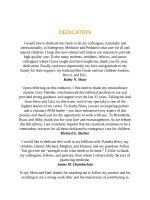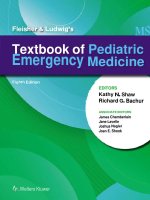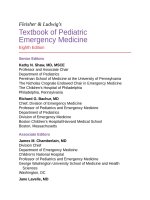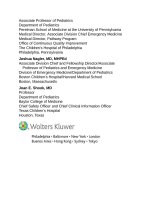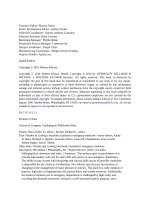Pediatric emergency medicine trisk 848
Bạn đang xem bản rút gọn của tài liệu. Xem và tải ngay bản đầy đủ của tài liệu tại đây (142.07 KB, 4 trang )
impractical for small children, who may inadvertently remove them from the
wound.
Tissue adhesives, or skin glues, such as octyl cyanoacrylate have become
widely used for wound closure in the ED. They allow rapid and painless closure
of wounds, though if glue gets into the wound, it can cause a burning sensation or
pain. Anesthesia is unnecessary, unless painful irrigation or exploration of the
wound are anticipated. No removal is needed because adhesives slough off after 5
to 10 days. They provide an excellent cosmetic result, comparable with sutures.
One study using plastic surgeons blinded to the method of repair graded the
wounds repaired with tissue adhesives to be cosmetically equal to sutured wounds
at 2-month and 1-year follow-up visits. For scalp lacerations, hair apposition
technique (HAT) can be performed with skin glue. A few strands of hair on either
side of the scalp laceration are separated, pulled across the wound in opposite
directions (pulling together the laceration), twisted together with glue applied to
the twisted region, and repeated along the length of the wound. HAT is a painless
method of repairing scalp wounds that don’t require follow-up for stitch or staple
removal.
Tissue adhesives act to decrease wound infections because they have
antimicrobial effects against gram-positive organisms. Dehiscence rates (1% to
3%) are similar to that of sutured wounds. They are less expensive than sutures
because less equipment is required and personnel time is reduced. Studies have
noted that some patients and families of small children prefer skin adhesives to
sutures. Routine follow-up is not needed for uncomplicated wounds, and no longterm complications have been reported. Newer products such as high-viscosity
octyl cyanoacrylate tissue adhesives are less likely to migrate during repair,
making wound repair easier to accomplish.
Before application of the tissue adhesive, the wound is cleaned and hemostasis
is achieved with dry gauze and pressure. The wound’s edges are held together
manually or with forceps while the tissue adhesive is applied along the surface of
the wound. The tissue adhesive should not be applied to the inside of the wound
because it will act as a foreign body and inhibit healing. The wound edges are
held in place for about 20 to 30 additional seconds to obtain adequate bonding. If
poor alignment of wound edges is noted, the adhesive can be removed with
forceps and reapplied without further complication. The wound is then covered
carefully so adhesive portions of any bandage do not directly contact the skin
glue, to avoid pulling off the tissue adhesive with dressing changes. Avoid routine
application of antibiotic ointments by parents as these will dissolve the adhesive
and cause dehiscence.
TABLE 110.3
COMMON TECHNIQUES OF WOUND CLOSURE
Technique
Advantages
Disadvantages
Sutures
Greatest tensile strength
Meticulous closure
Low dehiscence rate
Staples
Rapid application
Painful
Removal needed
Slow application
Increased tissue reaction
Risk of needlestick
(clinician)
Not for use on face (less
meticulous closure)
Tissue adhesive
Tape strips
Low cost
Low tissue reaction
Rapid application
Painless
No removal needed
Low cost
No risk of needlestick
(clinician)
Rapid application
Painless
Lower tensile strength
Not for use on joints
Not for use on bite wounds
High risk of dehiscence
Not for use in moist areas,
young children
Low cost
Low infection risk
Least tissue reaction
Tissue adhesives should be used only to close skin of superficial wounds. For
many lacerations, deep absorbable sutures will also be needed because the glue
has less strength than most sutures. Skin glues should not be used for wounds
subject to great tension, such as on the hands or joints, or bite injuries in which
occlusive closure increases the risk of infection. Table 110.3 summarizes
advantages and disadvantages of several techniques available for wound closure.
Wound Care
Wound Dressing
Appropriate wound aftercare is important in preventing contamination or further
injury. It is recommended that most sutured wounds be covered with antibiotic
ointment and a dressing immediately after closure. For simple lacerations, an
adhesive bandage (e.g., Band-Aid) is sufficient, however larger wounds may
benefit from a nonadherent sterile dressing to prevent wound edges from sticking
to the dressing. This nonadherent dressing should then be covered with a layer of
gauze then tape. This technique helps to protect and immobilize the wound.
For the face and trunk, a large bulky dressing is not practical. Thus, for small
wounds in those areas, a clear plastic adhesive (e.g., Tegaderm) should be used to
secure the bandage. Rolls of cotton or stretchable tube gauze can be used to wrap
larger wounds to keep the sterile dressing in place. This keeps the young child
from touching the wound. Scalp wounds are usually not dressed, though gauze
and tube gauze may be applied prior to sleep to avoid staining linens with blood
or drainage. Patients can generally wash their hair gently after 24 hours.
For children who are active, it may be best to keep the wound covered until
sutures are removed. The original dressing should remain in place for 12 to 24
hours after which epithelialization is usually sufficient to keep the wound from
gross contamination. One study showed that uncovering after 12 hours with
gentle washing does not increase the risk of infection. After 12 to 24 hours, the
bandage should be changed daily and the wound inspected. Any dressing should
be changed sooner if it becomes soiled, wet, or saturated with drainage because
the wet dressing may become a source of infection.
It may be advisable to splint the wound if it overlies a joint. This is most
important for active children who will likely resume full activity soon after the
injury. Some even recommend splinting nearby joints for any large laceration of
an extremity to reduce stress across the wound even if it does not involve a joint
itself. This should be done for no more than 72 hours to prevent muscle atrophy
or joint immobility. The injured extremity should be elevated to provide comfort
and reduce edema.
Topical Antibiotics
For most simple wounds, it is adequate to cover the wound with dry sterile gauze
after applying topical antibacterial ointment. There have been several studies
looking at the different infection rates between certain topical antibiotics and
petroleum ointment. Overall, it has been found that a triple antibiotic ointment
may be preferable in preventing Staphylococcus aureus infection although there
may be a slightly increased rate of contact dermatitis with use. Topical antibiotics
have been noted not only to prevent infection but also to help with
reepithelialization, decrease crust formation, prevent wound dehiscence, and aid
in suture removal.
Guidelines for Systemic Antibiotics
Use of prophylactic systemic antibiotics for wound management is controversial.
There are no data demonstrating proven benefits to the routine use of antibiotics.
In addition, antibiotics may lead to allergic reactions, growth of resistant
organisms, altering normal gut flora, and unnecessary expense. Decontamination
with proper irrigation is more efficacious than routine use of antibiotics to prevent
wound infection. Antibiotic prophylaxis may be considered in certain high-risk
wounds. These include heavily contaminated wounds, wounds with devitalized
tissue, bites (e.g., particularly cat, dog, and human), puncture wounds of the hand,
stellate lacerations, and lacerations near joints or over open fractures. Also,
patients who are immunocompromised should be considered for prophylactic
antibiotics. Data for the role for antibiotics in intraoral wounds is conflicting.
There are less data supporting the use of antibiotics in dirty wounds, but may be
considered in lacerations contaminated with soil or feces. Wounds that result in
exposed cartilage of the nose or ears or extensive facial wounds that may involve
contamination from adjacent nasal passages are often treated with antibiotics. It
may also be reasonable to use antibiotics for wounds (other than scalp lesions)
when repair takes place more than 12 hours after injury.
Usually, a first-generation cephalosporin or penicillinase-resistant penicillin is
used to cover staphylococci and streptococci. Amoxicillin–clavulanic acid is
recommended for wounds created by mammalian bites (see Chapter 94 Infectious
Disease Emergencies ). Additional coverage for gram-negative organisms with an
aminoglycoside is recommended for open fractures (see Chapter 111
Musculoskeletal Trauma ). Methicillin-resistant Staphylococcus aureus (MRSA)
in simple skin lacerations is less common, however if there is concern for high
rates of MRSA in the community, then clindamycin or trimethoprimsulfamethoxazole should be considered.
Guidelines for Tetanus
The immunization status of all injured patients should be documented in the
medical record. If the wound is clean and minor and the patient has received three
previous doses of tetanus toxoid, a booster of tetanus toxoid is given only if 10 or
more years have passed since the last dose. If a patient has received three or more

